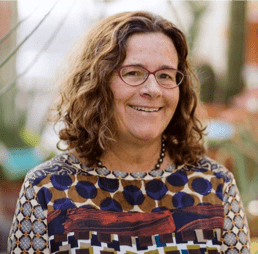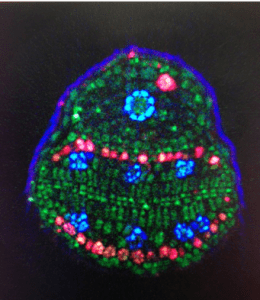 Ronald and Deborah Harris Professor,
Ronald and Deborah Harris Professor,
Department of Biological Sciences
Associate Director, Dartmouth Toxic Metals Superfund Research Program
Dartmouth College
Class of ’78 Life Sciences Center, Room 325
78 College Street
Hanover, NH 03755
USA
Tel: 603-646-2527
Fax: 603-646-1347
E-mail: Mary.Lou.Guerinot@Dartmouth.Edu
Web: The Guerinot Lab
Areas of Expertise: Metal transport; Molecular genetics
Member, Molecular Toxicology Group
Research:
Increasing the ability of plants to take up essential minerals could have a dramatic impact on both plant and human health. For example, iron deficiency afflicts over 3 billion people worldwide and plants are the principal source of iron in most diets. We have employed the tools available in the model plant Arabidopsis to identify genes involved in metal homeostasis including metal reductases and metal transporters. Our lab is also currently trying to unravel how cells perceive iron status and translate that information into changes in gene expression. We have identified several transcription factors that control the iron deficiency response in Arabidopsis. Working with collaborator David Salt, we have been part of the team that developed ionomics in which high throughput multi-element ICP-MS analysis is combined with bioinformatics, genomics and genetics to deliver a truly effective functional genomics platform for the discovery of new gene functions. Using this platform in collaboration with rice breeder Shannon Pinson and arsenic experts Andrew Meharg and Adam Price, we have identified several loci that influence the arsenic content of rice grain.
Some current projects include:
 Metal Homeostasis in Arabidopsis. Why do plants need so many ZIP transporters? With 16 ZIP family members, we are working to understand the role of each in metal uptake from the soil and transport throughout the plant. We are also interested in understanding, which residues contribute to metal specificity, as different members of the ZIP family are capable of transporting different metals, including iron, zinc, manganese and cadmium. We have also been investigating the role of an iron transporter, VIT1, that is located on the vacuole membrane and functions to remove iron from the cytoplasm, presumably for storage in the vacuole. These projects all take advantage of the fact that we can easily assay for function in yeast. The newest project in the lab uses synchrotron X-ray fluorescence microtomography to precisely determine where metals are localized in plant tissues. The image shown to the right is a tomogram taken through the center of an Arabidopsis seed. By analyzing mutants, we now know that the VIT1 transporter is responsible for setting up the iron pattern (shown here in blue) and the MTP8 transporter determines the manganese pattern (shown here in red). Calcium is shown in green.
Metal Homeostasis in Arabidopsis. Why do plants need so many ZIP transporters? With 16 ZIP family members, we are working to understand the role of each in metal uptake from the soil and transport throughout the plant. We are also interested in understanding, which residues contribute to metal specificity, as different members of the ZIP family are capable of transporting different metals, including iron, zinc, manganese and cadmium. We have also been investigating the role of an iron transporter, VIT1, that is located on the vacuole membrane and functions to remove iron from the cytoplasm, presumably for storage in the vacuole. These projects all take advantage of the fact that we can easily assay for function in yeast. The newest project in the lab uses synchrotron X-ray fluorescence microtomography to precisely determine where metals are localized in plant tissues. The image shown to the right is a tomogram taken through the center of an Arabidopsis seed. By analyzing mutants, we now know that the VIT1 transporter is responsible for setting up the iron pattern (shown here in blue) and the MTP8 transporter determines the manganese pattern (shown here in red). Calcium is shown in green.- Iron Regulation. As part of an NSF funded project, we have identified an upstream regulator of the essential iron transporter IRT1 called uri that controls most of the iron-regulated genes in Arabidopsis. URI encodes a bHLH transcription factor that is not iron-regulated. Another NSF-funded project is joint with the McClung lab and is examining the relationship between the circadian clock and iron regulation. We have also identified a mutant that accumulates iron due to constitutive expression of the iron deficiency response genes.
- Ionomics. Understanding the functional connections between genes, proteins, metabolites and mineral ions is one of biology’s greatest challenges in the postgenomic era. As part of a multi-investigator project, we are using ICP-MS [inductively coupled spectroscopy-mass spectroscopy] nutrient and trace element profiling as a tool to determine the biological significance of connections between a plant’s genome and its elemental profile. We are screening loss of function mutants in each of the predicted ORFs in the Arabidopsis genome and have already identified a number of proteins of unknown function that dramatically alter a plant’s elemental composition.
- Arsenic. Rice, a staple food for over half the world’s population, represents a significant dietary source of As, a non-threshold, Class 1 human carcinogen. Arsenic occurs naturally in soil and was used for many years in pesticides in fields now used to grow rice. This NIESH-funded project aims to study the genetic control of As homeostasis in plants to enable the development of plants that do not accumulate As, safeguarding human food crops. The long-term goal is to safeguard the edible portion of rice grain (endosperm) from As accumulation, but the work will also potentially provide information on genes responsible for transporting As, and other contaminant metals into the tissues of other edible plant organs. We have used synchrotron x-ray microprobes to precisely localize As in the plant, an approach that we used successfully to elucidate the role of an important iron and manganese homeostasis genes. Understanding the pathways of arsenic accumulation in plants will allow the development of crops which do not take up arsenic, creating healthier food sources, or plants which can more effectively extract arsenic from the soil as a strategy to clean up polluted lands and water.